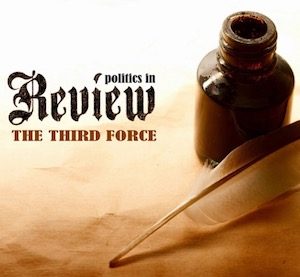
“In Malaysia, the opposition of the eighties and nineties could not even afford to engage in a disinformation campaign, forget perception or the money. If it did, Dr Mahathir Mohamad would have stuffed its members in prison like sardines in a can under the now defunct Internal Security Act (ISA). While that forced parties like the DAP to speak truths and keep gazettes circulated only among its members, Mahathir had a gala time twisting and turning facts to conceal his crimes and those of his cronies”
THE THIRD FORCE
Early in the middle ages, not only was paper widely regarded to be a sign of wealth, it was was made accessible only to the elites. Such was the era, the nobles had books locked up in monasteries and exercised excessive control over the accumulation of knowledge. They believed that commoner was bereft of divine inspiration and lacked the capacity to think rationally. They were absorbed with the idea that scholarly knowledge was godsend and meant only for their consumption.
These attitudes dampened the spirit of the commoner and robbed him of all his self-worth. By the mid ninth century, the man on the street believed that he was born only to serve the state and took everything the ruler said gospel. The elites, on the other hand, began to think of themselves as demigods who were on earth to ‘rescue’ mankind from the labyrinths of ignorance. These sets of beliefs fuelled one another and became the cornerstone to medieval thought and culture.
Because of that culture, the elites were able to ‘own’ peasants and get them to work their fields for virtually nothing. Politically, the ruling class was able to keep a tight lid on mainstream ideology through paper gazettes only the elites could afford to produce. Each time one was stuck on to a tree, villagers would gather around it and behave as if the Gods had descended from the heavens to lead mankind to His path. The whole affair was so ritualistic, the elites were able to shove any amount of rubbish down the peasant’s throat and have him willingly gulp it down as if it were the holy nectar of wisdom.
That, in essence, was how the mainstream media was born, though not long thereafter came its revolution. The mid thirteenth century saw a sharp rise in the number of paper mills all across Spain and Italy, with England partaking in this revolution around the late fifteenth century. By the year 1400, it was quite common to find small volumes of sermons, folklore and philosophical treatises displayed on the shelves of drug stores. But it wasn’t until a German by the name of Johannes Gutenberg invented the printing press did paper lose its divine lustre among the peasant and artisan classes.
Thanks to Gutenberg, the higher demand for paper led to cost reductions and the dawn of the mainstream press. Its advent gradually shifted paradigms away from superstition and into the realms of rational thought. For a while, the press was controlled by wealthy interest groups that had agendas of their own. While that allowed the media to cover a broad spectrum of ideas, the scribblings of editors served more to incite than they did inform the people or educate them.
It soon dawned upon the ruling class that a free-for-all press threatened to spur critical thinking in ways detrimental to its survival. The rulers gradually took control of media and began sharpening conversations to better reflect their ideologies. Over time, the man on the street lapsed into ignorance and was very limited in his view of the world. That, in a queer sense, brought things back just the way they were during the Medieval era.
With a twist, of course – readers no longer defined news in print as divine and knew they were being led. But it is not as if they had a choice – the only way they could ever keep themselves abreast of happenings around the world was to subscribe to the local gazette. The minute they shunned it, they were lost. But the more they relied on it, the greater became the demand for paper and the need for faster and better printing methods.
That quickly led to a revolution in printing technology and triggered sharp reductions in both paper and printing costs. So sharp, the French opposition suddenly realised it could afford to print gazettes in appreciable quantities to advance its own ideology. In 1894, leaders of the French opposition began to disseminate fake news by spreading its own gazette among members of the general public.
The disinformation campaign was part of an elaborate scheme to topple the Government of France (GoF). The opposition would have succeeded had it not been for an eleventh-hour defection that presented the GoF with damning evidence. That evidence led to the conviction of a number of opposition leaders on charges of treason against the French Third Republic. The army general who led the opposition was so distressed by what happened that he even ended his own life while serving time in prison.
The bitter episode prompted the GoF to impose stringent controls over the distribution of print media that was not government sponsored. To regain public confidence, it cut down heavily on propaganda and focused instead on delivering legitimate news. The GoF could afford to do so given that the French opposition was too fatigued to pursue resistance. But the minute it did, the government bounced right back into the spheres of propaganda and began twisting and turning facts like it never did before.
But things had changed.
The Dreyfus affair, as it was called, had exposed the people of France to such sensibilities, they no longer believed everything the government said. Its leaders began to see that the more the GoF curtailed freedom of press, the more people leaned towards the opposition for alternate views. That led to serious concern that the act of restricting media was itself lending support to opposition propaganda. Towards the late 1900s, the GoF adopted all provisions within the Press Law of 1881 to present the people of France a free press.
That perhaps marked the first time ever in human history that an earnest effort was ever made by any government anywhere in the world to loosen its grip on media. In the years that followed, whenever the French opposition spoke untruths or rubbished administrative policies, the GoF would spend hundreds upon thousands of francs (which, by today’s standards, is worth tens of millions of dollars) to dish out counterclaims that were dense with exaggeration and diversions. The opposition just couldn’t afford that kind of money and would always end up losing the perception war.
In Malaysia, the opposition of the eighties and nineties could not even afford to engage in a disinformation campaign, forget perception or the money. If it did, Dr Mahathir Mohamad would have stuffed its members in prison like sardines in a can under the now defunct Internal Security Act (ISA). While that forced parties like the DAP to speak truths and keep gazettes circulated only among its members, Mahathir had a gala time twisting and turning facts to conceal his crimes and those of his cronies.
But that’s no longer possible.
Thanks to the internet, you can now get your message across to anyone anywhere in the world with just the click of a button. It’s dirt cheap these days to call Trump an orange calf and get 10,000 people to read about it. There is no way anyone can do anything to prevent you from disseminating fake news no matter how hard he (or she) tried. The problem isn’t just endemic to Malaysia – it’s happening all around the world.
As a result, governments of the world are now forced to focus on truths as they know opposites always attract. That is to say, if the opposition chooses to be on the side of lies, you simply have to be on the side of truth. There is no way any government anywhere in the world can exaggerate its way into the hearts of voters. And that is why, for the first time in 1,600 years, it is the government controlled media that is the one giving you the straight dope, not the online portal or the opposition gazette.
And yet, you have people believing in Roketkini, Malaysiakini, Free Malaysia Today and all their likes.



